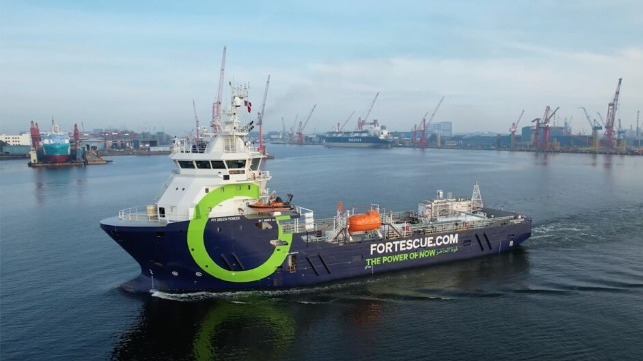Fortescue and China Cosco Cooperate on Ammonia-Fueled Ships

China Cosco, the world's largest shipowner, has agreed to work with Australian mining conglomerate Fortescue to build a new series of bulkers powered by green ammonia. The ships would be used to transport Fortescue's iron ore to China, without onboard emissions.
"The cooperation marks another big step in decarbonizing the shipping industry," said Fortescue in a statement. "These solutions will be integral to achieving our net zero Scope 3 emission target by 2040."
Fortescue already operates the world's first tested ammonia dual-fuel vessel, the OSV Fortescue Green Pioneer. In March, the ship underwent its first trial burning a combination of ammonia and diesel fuel at the Port of Singapore.
Fortescue has ambitious plans to eliminate its Scope 1 and Scope 2 emissions by 2030, and it views China as an essential partner. Chinese steel mills are the primary customers for Fortescue's iron ore exports, and the Australian company wants China's support in decarbonizing its operations.
Just last month, Fortescue welcomed Chinese Premier Li Qiang to its green-tech test center in Perth for a tour of zero-emission locomotives, hydrogen-powered trucks and ammonia-fueled engines. The key to the pitch, though, is to partially process the ore in Australia - making "green iron" - and then ship the product to China to turn into steel.
"Our proposed Australia-Sino green iron metal supply chain will bring together mining powered by large-scale renewable power and green hydrogen to produce green iron metal. Our ambition is to provide 100 million tonnes of green iron metal to China each year, eliminating more than 200 million tonnes of carbon dioxide emissions," Fortescue chairman and founder Andrew Forrest said in June.
However, Fortescue recently walked back its plans to produce 15 million tonnes of green hydrogen by 2030, citing the rising cost of green electric power. It has withdrawn from marquee developments like the "Project Coyote" hydrogen plant in British Columbia, which ran into political difficulties over its need for massive amounts of electricity from hydropower.
On Monday, Fortescue's stock price fell by nine percent on news that a large institutional investor had put $1.2 billion worth of the company's outstanding shares up for sale as a block, equivalent to three percent of Fortescue's share volume. Bloomberg has identified the investor as Capital Group.
No comments:
Post a Comment